Hand pump for a well: types of equipment, characteristics, their pros and cons
The well on the site helps to resolve the issue of autonomous water supply. But without special equipment, it is impossible to raise liquid to the surface. And I don’t want to buy expensive automatic devices if the dacha is visited from time to time, right?
A hand pump for a well of domestic or foreign production will cost much less. It is not difficult to deliver it, and it will be able to work even if there is no central electrical supply on the site.
But which option is better to choose? We will help to deal with these issues - in our publication we considered the design features of the most popular types of manual pumps, their capabilities, the main pros and cons. We also made recommendations on choosing the right equipment option.
The content of the article:
Features of manual equipment
The hand pump allows you to pump fluid from well arranged on siteto the selection point with little effort. The water flow here is much lower than in automatic devices. But manually pumping a bucket of water is not difficult - even a teenager can cope with this task.
However, linkage mechanisms have a number of significant advantages.
Among the key are the following positions:
- autonomy - the device can be used where there is no electric network, or the cost of electricity is too high, and connecting powerful equipment is not economically feasible;
- low material acquisition costs - a manual unit is much cheaper than an automatic one and there is not always a real need to pay a significant amount of money for equipment that will not be operated in a constant mode;
- universality - hand pumps on the market are presented in a wide range, you can choose a suitable device for both deep and shallow wells;
- maintainability - if any nodes of the lever models fail, they are very easily and quickly replaced;
- easy installation - installation does not require specialized knowledge and is carried out without the use of a specific, expensive tool:
- elementary use - in order for the pump to start supplying water, you only need to raise and lower the handle several times, even a child, woman or senior citizen can easily cope with this task.
The equipment has only two minuses. The first is the physical effort that you need to make to get fluid for drinking or watering. In this plan automatic pumpswho pump water from a well without the direct involvement of a person wins.
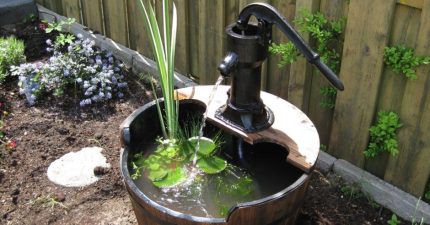
The second is low productivity compared to automatic units.
However, this cannot be considered a complete flaw. After all, such models are intended for installation in places where there is no need for constantly flowing water from the tap or uninterrupted supply is simply impossible to organize physically.
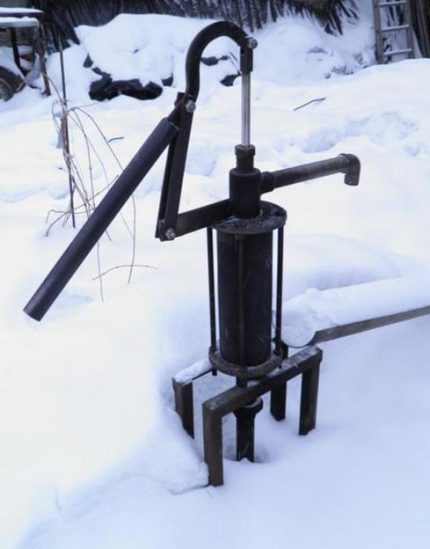
Typically, hand pumps are used in summer cottages, visited only in the summer, and in places where there are problems with the constant supply of electricity.
Manual models are also used as an accompanying option for water supply. So, it will be quite difficult to provide the required amount of water with vegetables every day. A hand pump will help to cope with this task, and without extra costs for paying for electricity.
Varieties of Hand Pumps
Manual equipment for pumping water on the market is presented in a wide variety of options.
The following product types are offered to well owners:
- winged;
- piston;
- barbell;
- membrane.
Each species has features that determine the area of maximum effective use. Regardless of the design and principle of operation, all devices demonstrate approximately the same performance.
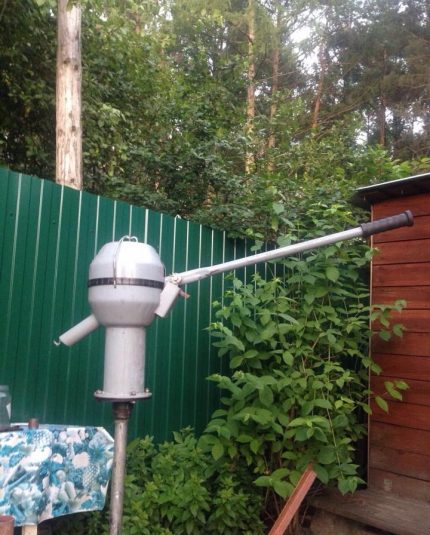
About one liter of fluid will be produced in one full cycle of reciprocating movement from the well. For a minute in this way you can draw from 20 to 40 liters of water. A more accurate figure depends on how often the user can raise / lower the lever-handle.
View # 1 - wing units
The manual vane pump is a compact device for pumping water from underground sources 5-7 meters deep. The small size allows the device to be used for technical purposes in factories, warehouses, bases and other areas where it is not possible to mount more powerful and overall equipment.
Structurally, the product consists of a housing with pressure and suction nozzles. The impeller with blades is fixed on the shaft, tightly connected to the handle of the device. The upper compartment of the device maintains a constant volume even if the impeller changes its position.
The lower part of the working chamber of the pump is divided into two parts by special jumpers. Two valves stand on the blades of the pump, and two more, working as a counterbalance to them, are placed at the entrance to the lower chamber.
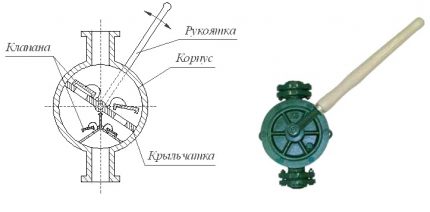
In the process of acting on the handle of the user, the impeller begins to rotate. Alternating zones of increased pressure and discharge are formed in the working chamber. The fluid is sucked in through the inlet and is vigorously pushed out through the pressure port. Pump valves allow water to move along the communication lines in only one direction.
Vane-type hand pumps can handle fairly viscous fluids, but do not tolerate contaminated fluids. Not suitable for transporting water containing fragments of liquid fuels, alcohols, paraffin, edible oils and any abrasive materials. Work well with clean shallow wells.
Often can be used in basements where it is not possible to place more powerful and bulky equipment. At a budget price, they are sold in an anodized metal case.

Among the models of foreign manufacturers are popular German K1 and K2 with brass valves and vanes. Russian analogue of RK2 sold at a higher price, but equipped with a wing mechanism made of metal, prone to corrosive manifestations.
Advantages of vane pumps: compact dimensions, the ability to pump viscous fluids.
Of the minuses: low productivity, high demands on the purity of water, work in small wells.
View # 2 - piston type pumps
Reciprocating devices are very popular. Structurally, they consist of a cylindrical body made of stainless steel. The piston moves inside, by means of a rod fixed on the lever-beam.
Elastic fluoroplastic seals provide a snug fit of the piston disc to the walls. Spherical check valves are located on top.
Pumps of this type create inlet pressure. They are placed 1 meter above ground level. They are mounted on the upper part of the casing communications in such a way that the system check valve is located at the outlet of the water pipe immersed in the hole.
Used where the water mirror is located high. They extract water from wells up to 10 meters. From deeper sources they cannot raise liquid to the surface. Great physical effort to push the lever mechanism does not require.
During the progressive movement of the piston, the valve lowers and prevents the outflow of fluid in the opposite direction. Water under pressure opens the built-in valves and rises above the surface of the piston disc.
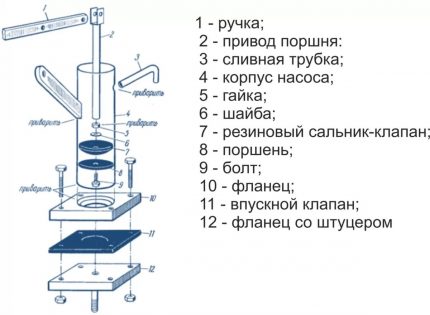
During the reciprocating movement of the piston, the valve lowers and prevents the outflow of fluid in the opposite direction. Water under pressure opens the built-in valves and rises above the surface of the piston disc. During the return stroke, the disc valves close, preventing water from flowing down.
The air pumped into the system pushes the liquid upward under pressure and as a result, it pours out through the pump outlet drain pipe.
In the ranking of the best-selling piston models, the top positions are occupied by steel appliances with galvanized bolts from Russian manufacturer Watergood. Products of foreign brands are less popular.
Advantages of piston pumps: pumping both clean and turbid water with sand, suitability for working with light oil products, acids, solvents, alcohols.
Another plus is the simplicity of the design - for example, a piston type pump can make at home.
The main disadvantages: some models require insulation for the winter, as they cannot be used if the ambient temperature drops below +1 ° C. Usually this information is indicated on the manufacturer's website and in the accompanying technical documentation of the device.
View # 3 - rod (rod) devices
Sucker rod pumps are sometimes called sucker rod pumps. They are used where water lies at a depth of 12-30 meters. For all other manual models this is an impossible task.
By design, the devices are a bit similar to piston units. As the main working unit, a cylinder and a piston with an elongated end are used here. The pump part of the device is located in the aquifer.
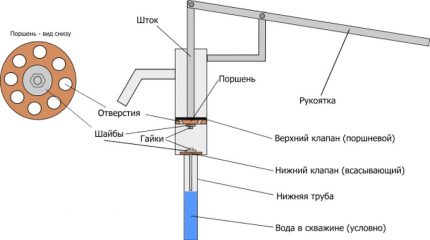
Rod-type equipment is mounted directly into the well. The rod part is immersed in water to a depth of about 1 meter.
Pumping of water begins when a person sets in motion a lever device. The piston lowers and the bottom valve closes. The resulting pressure opens the upper valve and the fluid moves into the space above the cylinder.
In the process of lifting the piston element, the water closes the upper valve, and the vacuum created under the piston opens the lower valve for suctioning water.

It is most important to use sucker-rod pumps in conditions where the water is too deep to install an outdoor electrical appliance, the diameter of the well does not allow the automatic pump to be mounted or it is not possible to connect to the electrical network. In all other situations, spending money on equipment is impractical.
The main advantage of sucker rod pumps is the lifting of liquids from great depths. A compact rod-type pump for wells up to 15 m deep can be manufactured at home. We recommend that you familiarize yourself with the detailed manufacturing instructions homemade pumps from improvised materials.
Of the minuses of the purchased models, the complexity of the installation, the bulkiness of the design, the great effort required for pumping, the inability to use the unit in wells placed on bevels or having internal curvature, a high risk of rod breakage.
View # 4 - membrane equipment
Manual diaphragm or diaphragm pumps are very robust. Equally successfully, they can pump clean / contaminated household water and diesel fuel that has impurities. Even if there are a large number of small particles of sand and abrasive elements in the liquid, all nodes work flawlessly.
Ball valves do not occupy a fixed place, do not rub against each other, but are constantly rolled. This contributes to self-cleaning and reduces to zero the risk of jamming.

The round instrument case is made of durable plastic or cast from high-quality cast iron. Membranes and valves are made from oil and petrol resistant rubber. The equipment lasts for years and does not fail. Suitable for use only in shallow wells.
You can use the device not only for pumping water of any quality, but also for draining sewage or rainwater from cellars, cellars, trenches and other areas that have been flooded.
Among buyers are in demand models from Danish concern Grundfos and taiwan ampik pumps. They are sold at the best price.
Among the advantages are wear resistance, undemanding to the quality of the pumped water, optimal weight, loyal cost, durability.
The main disadvantage is the ability to work in shallow wells (up to 6 meters).
Recommendations for choosing a hand pump
Choosing a manual pump, you must first focus on the depth of the well. If it is from 5 to 7 meters, all varieties of portable pump-action devices will cope with the task. For sources where the water mirror is at a height of 10 meters, any lever equipment other than winged is suitable.
Only a hand-held boom device can raise liquid to a surface from a depth of 30 meters. But for this, the well should not have bevels or bends.
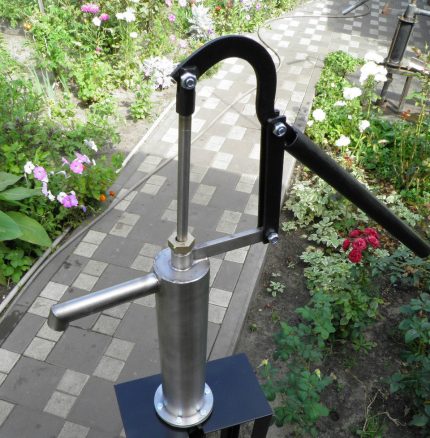
The weight of the lever equipment is from 4 to 130 kg. This parameter is relevant at the time of transport. Light products up to 15 kg can be delivered to the installation site on their own. Heavier models will have to be transported by car and use the services of hired workers for loading / unloading.
When installing heavy hand pumps, problems also often arise. Usually, the owner needs third-party assistance when carrying and during the installation of the device. It is advisable to think about this in advance and invite the master or use the services of someone from relatives, friends or acquaintances.
Another important element when choosing a model is water quality. The wing units in this regard are very demanding and can not cope with pumping liquids containing sand and impurities.
If there is a problem with the purity of water in the area, it is worthwhile to prefer piston, rod, or diaphragm pumps. They will normally complete the task and will not fail after passing through the system of small abrasive particles.
Do you need a functional pump for pumping dirty water, but the manual version is not suitable? We recommend that you familiarize yourself with best auto modelspresented on the market and selection rules.
If the equipment is only needed for operation in the summer, it is worth considering pumps with a plastic casing. They are sold at a lower price, are lightweight and are considered a budget option. But they do not withstand serious workloads and often fail, not having worked even for one season.
Products made of thin-walled food steel are considered more durable than plastic. The maximum period of use are cast iron and bronze appliances. The high price in them is compensated by a long operational period, reliability and resistance to manifestations of the external environment. All metal aggregates are suitable for year-round use.
The appearance of the pump also matters. It is desirable that it harmoniously blends with all other elements on the site and does not spoil the surrounding landscape. Some manufacturers produce hand pumps with spectacular handles and stylish taps. Such products are valued more expensive, but fully justify the cost, turning from a familiar element into a decorative object.
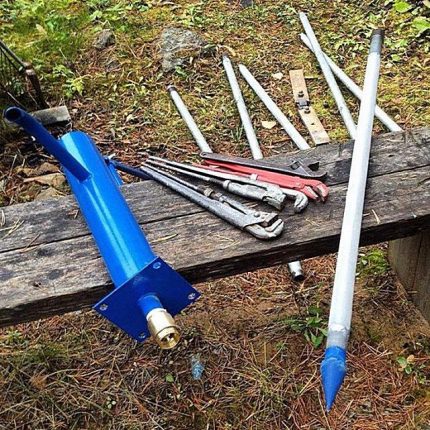
To ensure that the pump always works correctly and does not break, you need to take care of it, clean individual components and lubricate them with special tools.Some models have a self-cleaning system. Additional service to such devices is not required.
If you plan to spend a lot of time in the country, then you can not do without automation of the water supply system. In this case, we recommend that you familiarize yourself with rated pumping stationswhich are in demand among buyers, and the rules for choosing the best.
Conclusions and useful video on the topic
Technical characteristics and features of a piston hand pump with a cast iron housing.
The principle of operation of the piston type manual pump mechanism.
How does a sucker rod pump work? A real user demonstrates the process of extracting water from a well.
Using a hand pump is a good way out for owners of summer cottages or country houses of temporary residence. The equipment is inexpensive, easy to install, does not require an electrical connection and supplies water from sources with a depth of 5 to 30 meters.
The lever pump works in any weather conditions and withstands intensive use. It can be used to organize an additional water distribution point in areas where the main water supply is located far from irrigation sites.
Do you use a manual pump at your cottage? Show your pump model in the comments, share the impression of its use. Or just look at this option of pumping equipment, evaluating its pros and cons? If you have any questions about choosing the right type of hand pump, do not hesitate to ask our experts and other visitors to the site for advice. The feedback form is located below this publication.

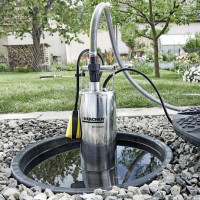 How to choose a pump for a well: recommendations for choosing pumping equipment
How to choose a pump for a well: recommendations for choosing pumping equipment  Well pumps: the best models + tips for choosing equipment
Well pumps: the best models + tips for choosing equipment 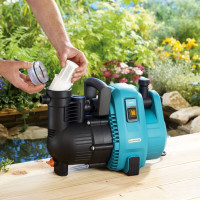 TOP-12 centrifugal pumps for a well: rating of the best + recommendations for choosing equipment
TOP-12 centrifugal pumps for a well: rating of the best + recommendations for choosing equipment  DIY manual water pump: a review of the best homemade products
DIY manual water pump: a review of the best homemade products 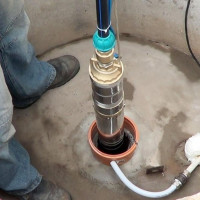 Submersible pumps for the well: 15 best models + tips for customers
Submersible pumps for the well: 15 best models + tips for customers 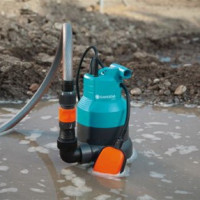 How to choose a drainage pump: review of options + rating of the best equipment on the market
How to choose a drainage pump: review of options + rating of the best equipment on the market  How much does it cost to connect gas to a private house: the price of organizing gas supply
How much does it cost to connect gas to a private house: the price of organizing gas supply  The best washing machines with dryer: model rating and customer tips
The best washing machines with dryer: model rating and customer tips  What is the color temperature of light and the nuances of choosing the temperature of the lamps to suit your needs
What is the color temperature of light and the nuances of choosing the temperature of the lamps to suit your needs  Replacement of a geyser in an apartment: replacement paperwork + basic norms and requirements
Replacement of a geyser in an apartment: replacement paperwork + basic norms and requirements
Are there combined pumps that pump in both manual and automatic mode? We often cut off electricity, then the manual mode would be useful.
It all depends on the type of pump that you use (surface, submersible, borehole), so giving a definite answer will not work. In any case, today such combinations are issued less and less. Therefore, it would be more advisable to mount a manual pump for the well separately. This way you will always have a running pump, even when there is no power supply. As an alternative solution to this problem, you can purchase a gasoline or diesel generator, from which you will supply power to the downhole pump.
But the best option is the simultaneous installation of a hand pump in parallel with an electric pump, as well as the purchase of a generator. In this case, you will be ready for any unforeseen situations. In addition, any equipment and machinery in the house can be powered from the generator.